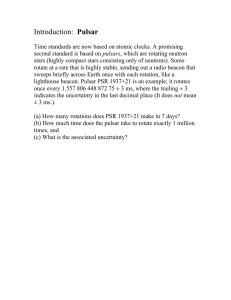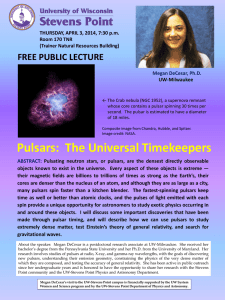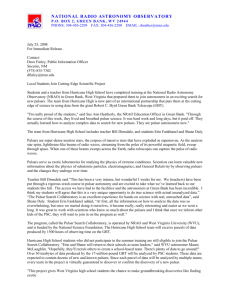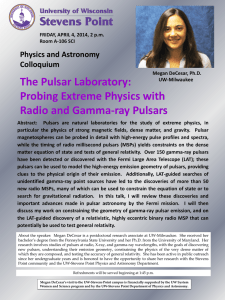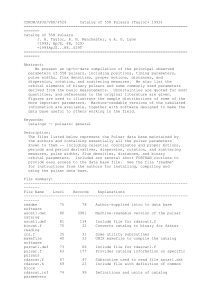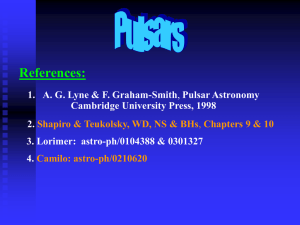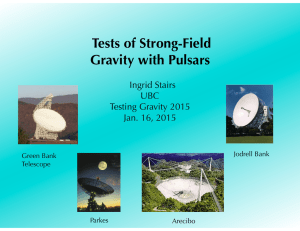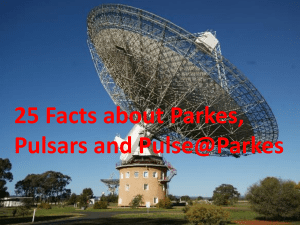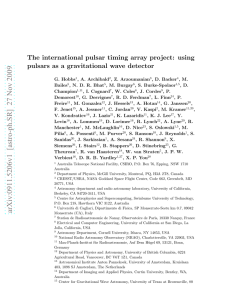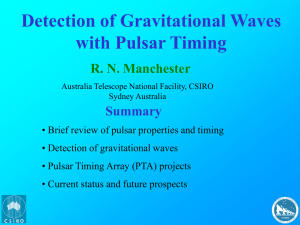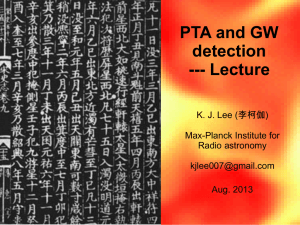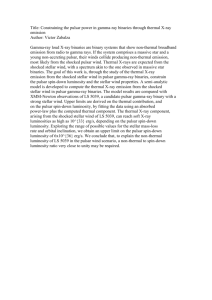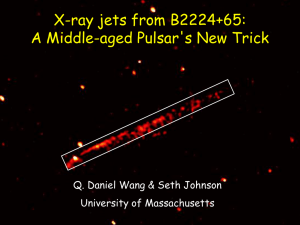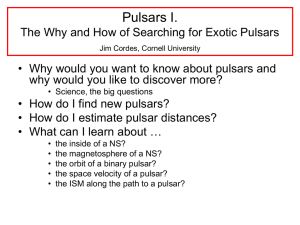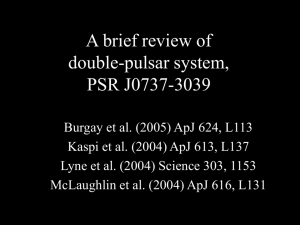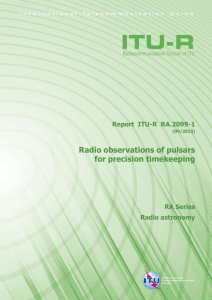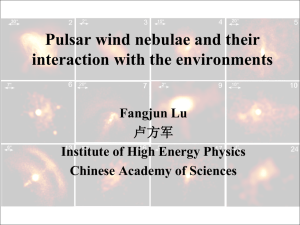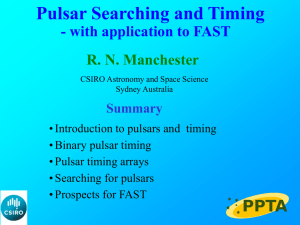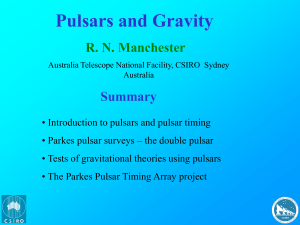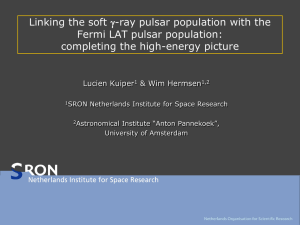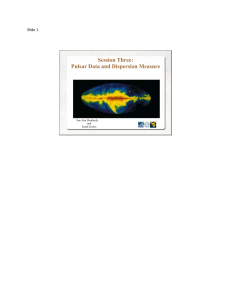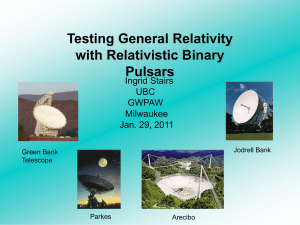Andrea Lommen
advertisement
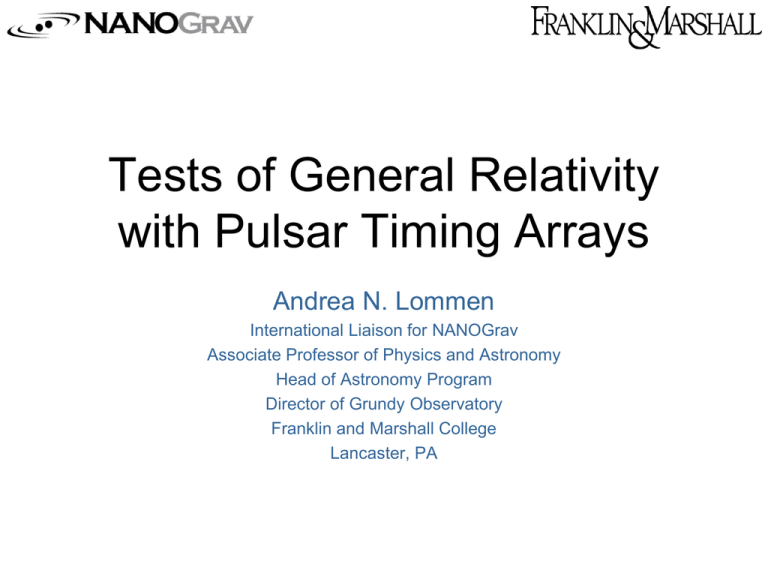
Tests of General Relativity with Pulsar Timing Arrays Andrea N. Lommen International Liaison for NANOGrav Associate Professor of Physics and Astronomy Head of Astronomy Program Director of Grundy Observatory Franklin and Marshall College Lancaster, PA Different geometries R=9km R=12km R=16 km What is a pulsar? Timing residuals versus time: J1713+0747 J1909-3744 Slide courtesy of Paul Demorest Photo Courtesy of Virgo Pulsar1 Pulsar2 Earth Adapted from NASA figure Detectability of a Waveform g h dt 2 dx j dx k dx j dx k r h jk t, x jk d d d d d 1 km n m dt d 1 k n m m r dn n h jk t , x j k h0 m m Residual e jk n n 1 k n f t f t L 1 k n m 0 m 0 2 r r ˆ where h jk t, x h0 f t k x e and L is the dist ance to the pulsar. j k A sense of what’s detectable h M 5 3 2 P 3d hP 5 3 M P d 1 3 5 3 P 3 M 9 2 10 M 1year 50ns d 100Mpc 1 NANOGrav Residuals Adapted from Demorest et al (2013) by David Nice NANOGrav 5-year timing results summary Demorest et al (2013) Orbital Motion in the Radio Galaxy 3C 66B: Evidence for a Supermassive Black Hole Binary Sudou, Iguchi, Murata, Taniguchi (2003) Science 300: 1263-1265. Residual(s) Residual(s) Constraining the Properties of Supermassive Black Hole Systems Using Pulsar Timing: Application to 3C 66b, Jenet, Lommen, Larson and Wen (2004) ApJ 606:799-803. (NANOGrav) 10 0 -10 Simulated residuals due to 3c66b 10 0 -10 Data from Kaspi, Taylor, Ryba 1994 15 The shape of the GW response Thanks Bill Coles A 5 x 109 solar-mass black hole binary coalescing 100 Mpc away. 30 IPTA pulsars, improved by 10, sampled once a day. Maximum Entropy based on Summerscales, Burrows, Finn and Ott 2008 Thank you to Manuela Campanelli, Carlos O. Lousto, Hiroyuki Nakano, and Yosef Zlochower for waveforms. Phys.Rev.D79:084010 (2009). http://ccrg.rit.edu/downloads/waveforms Hellings and Downs Curve (Overlap Reduction Function) Courtesy of Rick Jenet (NANOGrav) and George Hobbs (PPTA). Original figure from Hellings and Downs (1983). Yardley et al 2011 (PPTA) Response maps from alternate polarizations Chamberlin et al, PhRvD (2012) Lee et al. (2008) for biweekly observations made for five years with rms timing accuracy of 100 ns, detecting non-Einsteinian modes will require: pulsars in the case of the longitudinal mode; •60 •60 for the two spin-1 ‘‘shear’’ modes; and •40 for the spin-0 ‘‘breathing’’ mode Sydney Chamberlin (UW Milwaukee, NANOGrav) Non-Einsteinian gravitational waves using PTAs Chamberlin et al, PhRvD (2012) Figure by Paul Demorest, NANOGrav (see arXiv:0902.2968 and arXiv:1201.6641) Measuring the Graviton Mass KJ Lee et al, ApJ (2010) Measuring the Graviton Mass KJ Lee et al, ApJ (2010) Optimization Amounts to redistributing observing time among pulsars • To detect a single source, observe only halfdozen best of your pulsars (Burt, Lommen & Finn 2011 and recent work by Xavi Siemens) • To detect the stochastic background, maximize the number of pulsars • To detect (or rule-out) longitudinal modes, observe a few sources close together in the sky The Pulsar Data Challenge • Opened a week ago (March 23) • Will close in Sept • Go to www.ipta4gw.org Question #0 • How much do the tests on GR that you can do with binary pulsars matter? Question #1 • How should we optimize the pulsar timing array? Question #2 • What is the best method for detecting alternate modes? – Bayesian analysis – Frequentist – What would convince you? Question #3 • What effect would other theories of gravity (besides the conservative notion I’ve taken here that it’s GR but not standard polarization) have on pulsar timing and how would I test those? Question #4 • Can we do tests on the existing IPTA data challenge data? Is there a different data set we need to ask them to produce in order to test alternate theories? Questions • 0. How much do the tests on GR using binary pulsars matter? • 1. How should PTAs be optimized? Which pulsars should we observe most? • 2. What is the best method for detecting alternate modes? • 3. What effect would other theories of gravity have on pulsar timing and how would I test those? • 4. Can you do tests of alternative theories of gravity on the existing IPTA data challenge data?
